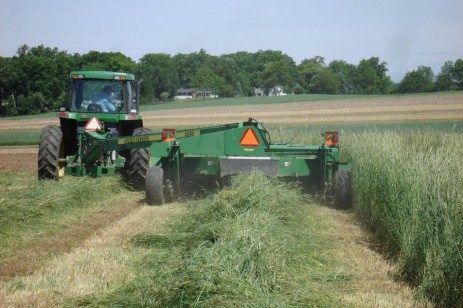By: Dwight Lingenfelter and John Wallace
Chopping cereal rye prior to anthesis is generally not an effective method of termination. Previous Penn State field trials have demonstrated that chopping rye at the late-boot stage can result in up to 80% regrowth and chopping at the mid-heading stage can result in up to 50% regrowth. Spraying cereal rye with common burndown products (glyphosate, paraquat, etc) prior to ryelage harvest is illegal. Consequently, termination of cereal rye that has been harvested for forage is best managed with post-harvest herbicide applications.
Glyphosate is a more effective burndown option than paraquat for post-harvest termination of cereal rye (see additional details below). It is likely not necessary to delay termination after harvest to allow for regrowth when using glyphosate as long as the harvest height results in enough green leaf tissue at the base of plants to absorb the systemic herbicide and weather conditions (> 55°F) are optimal for uptake and translocation. Cooler temperatures (< 50°F) will slow the activity of glyphosate and may impact termination efficacy of cereal rye following a mowing event. If using paraquat, termination efficacy is likely to increase when application timing is delayed after forage harvest to allow for adequate rye regrowth.
Furthermore, glufosinate (Liberty) and grass herbicides (Group 1), such as clethodim (Select) or quizalifop (Assure), are unlikely to be effective burndown alternatives to glyphosate for control of winter cereals, particularly when applied during periods of colder temperatures in the spring. In soybean, it will be a better approach to use glyphosate as the pre-plant burndown product for winter cereals and use timely post-emergence applications of a Group 1 herbicide to control small summer annual grass weeds as an alternative to a post-emergence glyphosate pass. Post-emergence corn herbicides that have activity on small summer annual grass weeds, such as nicosulfuron (Accent), rimsulfuron (Basis Blend) and Group 27 products (Impact, Shieldex, Laudis) will not likely control winter cereals that survive pre-plant burndown programs. Consequently, it is important to optimize glyphosate- or paraquat- burndown programs to achieve complete control of winter cereals if glyphosate is in short supply.
PENN STATE RESEARCH ON CEREAL RYE CONTROL AFTER CHOPPING
For those interested in additional information about some research we conducted on this topic during the "Bill Curran Era", here are some details.
Producers wishing to no-till corn into rye harvested for silage are sometimes concerned with rye regrowth. How long must you delay a burndown herbicide application after chopping rye to effectively prevent regrowth? Many years ago, we conducted a small experiment at our Rock Springs Agronomy Farm examining several herbicide treatments. The rye was chopped to about a 2-inch stubble height on May 5, while in the early head stage of development. Glyphosate was applied at 0.75 lb ae/acre (32 oz glyphosate 4L product) and Gramoxone was applied at 0.5 lb ai/acre (equivalent to 1.3 pt Gramoxone 3.0 SL) to the rye stubble at three different times following harvest. Glyphosate or Gramoxone were also applied with 1.1 lb/acre atrazine 90DF. The herbicides were applied the same day (0 day), 3 days, and 7 days following rye harvest. Rye regrowth was visually evaluated in each herbicide treatment/timing and also harvested approximately 6 weeks after the burndown herbicides were applied. No crop was planted in this experiment.
No rainfall was received until about 15 days after harvest which likely impacted our results. Glyphosate alone and with atrazine effectively killed the rye regardless of timing (see following table). Apparently, an adequate amount of green leaf tissue was present at the base of the plants to absorb the systemic herbicide. The addition of atrazine did not improve or reduce control with glyphosate. For the most part, Gramoxone was less effective for control of rye than glyphosate. Gramoxone applied the day of planting and 7 days after planting was sometimes better than the 3 day after harvest treatment, probably because of subsequent plant stress that developed following the mowing. Adding atrazine to Gramoxone either improved or did not affect rye control. With more timely rainfall following the herbicide applications, the addition of atrazine should have greatly improved control with Gramoxone. Also, a higher rate of Gramoxone SL 3.0 (2.7 pt/acre) should improve performance.
This study demonstrates the superior performance of a systemic herbicide (glyphosate) compared to a contact herbicide (Gramoxone) in this type of application. Delaying application following harvest may not be a concern if cutting height and the presence of healthy basal leaves at application time ensures adequate control with glyphosate.
Effect of herbicide and application timing on control of rye regrowth at Rock Springs. Plots were evaluated about six weeks after rye harvest.
| Herbicide | Rate (product/A) | Timing | % Regrowth* |
|---|---|---|---|
| Glyphosate 4L | 1.0 qt | 0 day | 0 a |
| Glyphosate 4L + atrazine 90DF | 1.0 qt + 1.1 lb | 0 day | 0 a |
| Gramoxone** + NIS | 1.3 pt + 0.25% | 0 day | 22 de |
| Gramoxone + NIS+ atrazine 90DF | 1.3 pt + 0.25% + 1.1 lb | 0 day | 15 cd |
| Glyphosate 4L | 1.0 qt | 3 days | 4 ab |
| Glyphosate 4L + atrazine 90DF | 1.0 qt + 1.1 lb | 3 days | 6 ab |
| Gramoxone + NIS | 1.3 pt + 0.25% | 3 days | 47 f |
| Gramoxone + NIS+ atrazine 90DF | 1.3 pt + 0.25% + 1.1 lb | 3 days | 25 e |
| Glyphosate 4L | 1.0 qt | 7 days | 8 abc |
| Glyphosate 4L + atrazine 90DF | 1.0 qt + 1.1 lb | 7 days | 2 a |
| Gramoxone + NIS | 1.3 pt + 0.25% | 7 days | 17 cde |
| Gramoxone + NIS+ atrazine 90DF | 1.3 pt + 0.25% + 1.1 lb | 7 days | 12 bc |





Post a comment
Report Abusive Comment